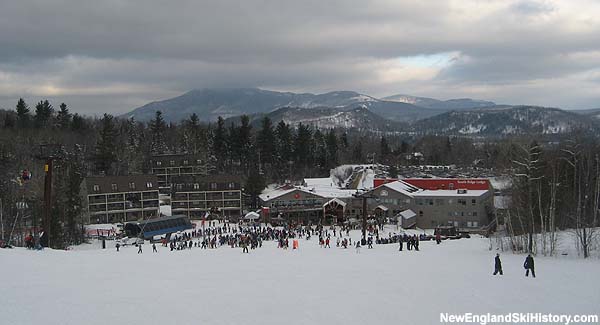
|
| Sunday River |
| Newry, Maine |
| Status: |
Open
|
| First Season: | 1959-60 |
| Vertical Drop: | 2340 feet |
| Standing Lifts: | 1 chondola, 1 high speed eight, 1 high speed six, 2 high speed quads, 4 quads, 5 triples, 1 double, surface lifts |
| Past Lifts: | 2 high speed quads, 2 triples, 3 doubles, surface lifts |
| Left: The South Ridge base area (2007) |
| Recent NewEnglandSkiIndustry.com News:
|
| 11/22/2025: Pre-Thanksgiving Skiing at Ski Areas in... | | 11/13/2024: Ski Season Resumes Tomorrow | | 10/30/2024: Chairlift-Served Ski Season Starts Tomor... | | 3/6/2024: Pleasant Mountain to Install High Speed... |
 |
|
Located just east of the northern White Mountains, Sunday River is one of New England's largest and most popular ski areas.
Local Beginnings
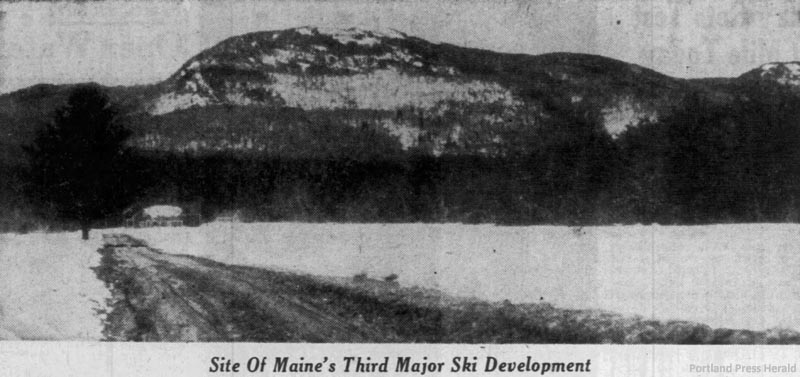
Sunday River circa early 1958 |
The origins of Sunday River date back to February 1958, when the Bethel Area Development Corporation was formed with local insurance executive Howard Cole elected as president, State Representative Addison Saunders as vice president, Bethel Savings Bank president and Gould Academy associate headmaster Edmond Vachon as treasurer, and Bethel Inn owner Guy Butler as secretary. The organization's goal was to seek new industrial development and find new winter business. A Winter Business Committee was formed, which reportedly looked at multiple potential locations for a ski area before settling on Barker Mountain (also known locally as Bald Mountain). The committee then obtained options for the needed land from Penley Brothers, Cross Brothers (future owners of Mt. Abram), and Richard Williamson.
On April 10, 1958, the Bethel Area Development Corporation announced plans for a $100,000 ski area, for which construction would start immediately. The group also announced that the site still had three to four feet of natural snow on the ground, making it a good location for spring skiing, with winter committee chairman Murray "Mike" Thurston stating that the area would have a ski season longer than any other in the east. The group hoped to open at least one top-to-bottom trail by the winter of 1958-59.
The group found that the access road only needed widening and surfacing, and that a parking lot could be located 500 feet from the proposed lodge. Lift service would be via a T-Bar up to 4,200 feet long by 1,600 feet vertical (terminating below the "snow fields"), as well as an 800 foot rope tow. Plans were made to hang chairs from the T-Bar in the summer for sightseeing, as well as to eventually construct a lodge atop the mountain. A future 2,000 foot T-Bar was planned for a north-facing "natural snow bowl."
Sel Hannah was hired as a consultant for the project, spending a weekend in mid-April inspecting the area. One of his first suggestions was to change the direction of the trails to a more northern exposure, as he found the initial layout to be too steep and the ledge to be more challenging for the lift installation. Hannah proclaimed, "There is excellent exposure at the natural snow bowl on the north east slope of Bald Mountain. There is no evidence of wind damage, and this along with ideal exposure assures you that you would be able to get most mileage out of the snow. The ground is not too rough, which is an indication the slopes could be grassed without too much expense." Hannah provided his services to the company in exchange for stock.
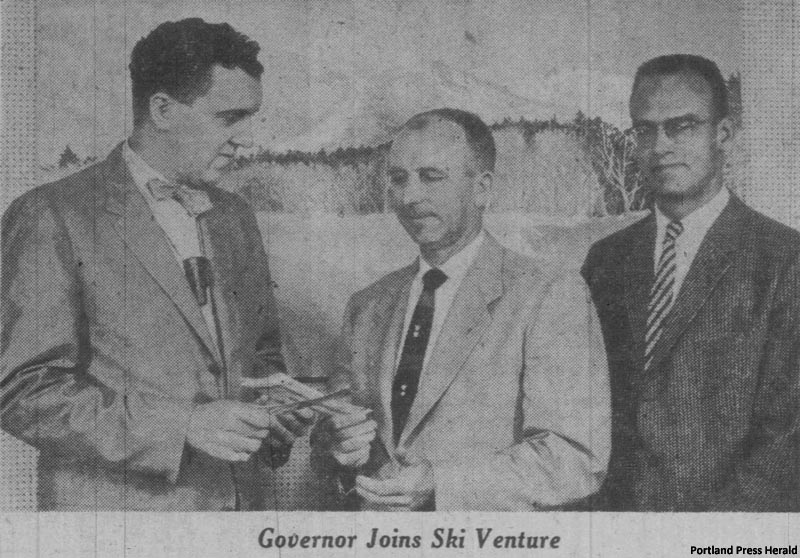
Governor Edmund Muskie purchasing stock from Addison Saunders and Murray Thurston |
The area finally received its name later that spring, as the Sunday River Skiway Corporation was formed on May 7, 1958. Governor Edmund Muskie purchased the first $10 share of stock in the company just before the Fourth of July, proclaiming "The people of Bethel should be congratulated for their fine spirit of cooperation which has led them to start this movement." The company set a $110,000 stock sales goal for July 15 in order to open for the 1958-59 season.
Trail clearing started on July 26, 1958, as a group of five volunteers began clearing a 25-foot wide path for the T-Bar survey. Trails were laid out on either side of the line by Sel Hannah.
Hopes of a 1958-59 season were dashed in September, when the group announced Securities and Exchange Commission issues had delayed the project. In addition, the group was still trying to find a contractor to clear trails.
Major trail clearing kicked off circa October, with logging company crews taking down valuable timber. A volunteer crew would then follow, cutting down and burning the remaining non-valuable timber. Development proposals were also altered, limiting the length of the T-Bar to 3,000 feet and size of the parking lot if the $110,000 sales goal was not substantially exceeded. Meanwhile, incentives were announced to increase stock sales, ranging from a one-year pass (for $250 in stock) to a lifetime pass ($1,000 in stock). Soon thereafter, shareholders were given a free day voucher for every three shares purchased.
By January 1, 1959 stock sales had nearly reached $30,000. Later that month, Sunday River directors met with Tebru Lifts to discuss the proposed T-Bar. Some directors reportedly travelled to Magog, Quebec to view a new Tebru lift in operation.
In March, the Sunday River Skiway Corporation entered into a contract with Sno-Engineering to take on all further surveying, engineering, and contractor arrangements on the development. Members of the Sno-Engineering team at the time were identified as Sel Hannah, Wildcat founder George Macomber, and former Mt. Sunapee manager David Heald.
On August 10, the Sunday River Skiway Corporation voted to proceed with construction, including the installation of a 3,200 foot long T-Bar in time for a December opening. Plans were also announced for a future T-Bar reaching to the summit of the mountain. Construction soon commenced for a 36 by 60 foot base lodge.
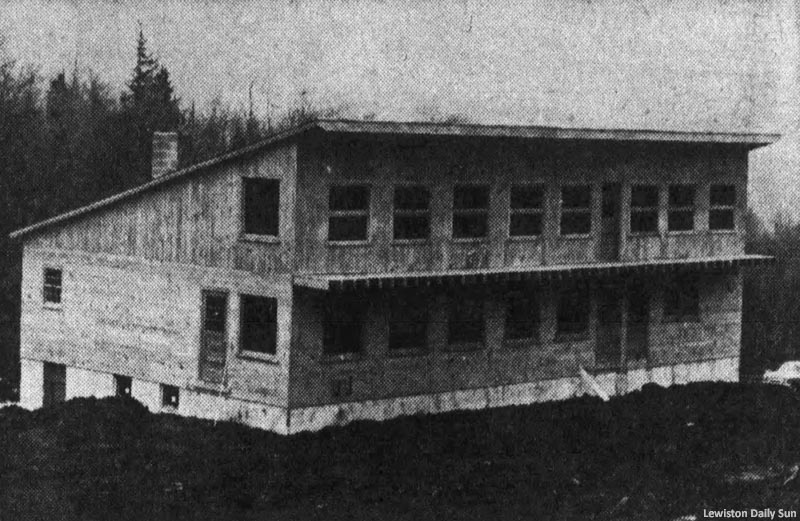
Construction of the original base lodge circa December 1959 |
In October, Clarence "Johnny" Rolfe was named manager of Sunday River Skiway. A native of Bethel, Rolfe had spent much of his life working as a lumberman and had been supervising construction of the ski area. By this point, trails were reported as mostly cut and foundations had been poured for the diesel-powered Hall T-Bar. In addition, the access road and parking lot were completed and the base lodge was being framed.
In November, Nils Torjesen was named ski school director. A competitive skier and jumper prior to serving as a Norwegian Army officer in World War II, Torjeson had relocated to Canada in the 1950s, leading ski schools at Deauville Estate and Country Club and Adele Lodge in Quebec, as well as Hornsjo, Norway.
Construction was nearing completion as December arrived, with Addison Saunders announcing that the area would open as soon as "we have any snow on the ground." T-Bar towers had been installed and the haul rope was being strung, while the two-story base lodge was completed. A 600 foot rope tow was installed for novices. By this point, the $100,000 project was reportedly funded by 20% local stock sales, $40,000 non-local stock sales, and $40,000 in Small Business Administration financing.
Sunday River Skiway Opens
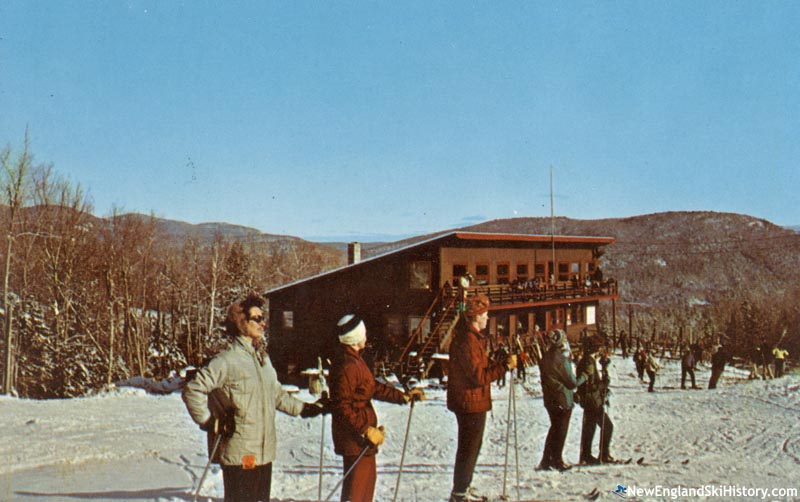
The original base lodge |
As a foot of new snow accumulated, Sunday River Skiway opened on December 29, 1959 with "nearly everyone in Bethel" on hand, according to a Portland Press Herald article. The cafeteria opened one day later, drawing raved reviews in the Portland Evening Express.
In February, plans emerged for a new novice slope to be constructed in time for the next winter. Favorable weather drew a crowd of 2,500 over the three-day Washington's Birthday weekend. In early March, Sunday River hosted the alpine ski events for Gould Academy's winter carnival.
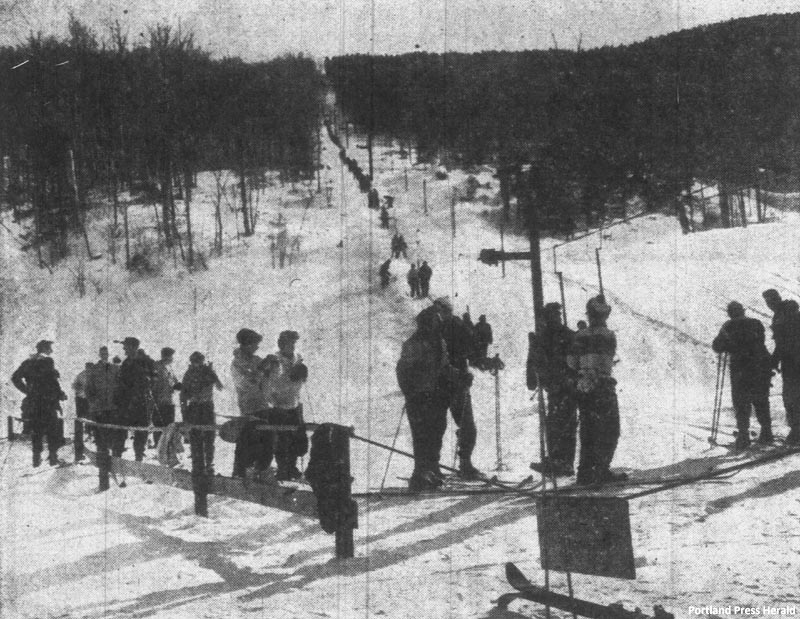
The T-Bar in February 1960 |
In mid-March 1960, Betty Potter of the Portland Press Herald reviewed Sunday River, writing "Despite the fact the mountain has only two trails open this year, the slopes were not crowded," adding, "Because Bethel is an infant in the business, skiers there make it a point to welcome newcomers to their areas, everyone knows everyone else and gay comraderie [sic] is prevalent." Potter noted that "The lodge is already too small and there is a definite need for more trails. There is plenty of mountain left to develop and plans call for expansion."
The best skiing of the season was reported in late March. Operations continued into the second weekend of April, with bare spots reported on the upper mountain. The directors of the corporation were reportedly pleased with the season, as business increased each month. Off-season plans included grading existing trails to enable skiing with less snow and cutting a new nearly mile-long trail on the north side of the area. Mike Thurston was elected president of the Sunday River Skiway Corp., replacing Addison Saunders.
In October 1960, Sunday River announced the construction of two new trails and the relocation of the novice rope tow. At the time, Sunday River's trails were not formally named. Leading the way was what would become Sunday Punch, described as a new 4,500 foot long by 200 foot wide intermediate trail. The intermediate Crossbow trail was also reportedly added. In addition, the existing (later known as) Cascades slope was improved, the base lodge painted dark brown, a snowcat ordered, and a survey line set for an upper mountain expansion.
As mid-December arrived, the new snow cat was delivered, but natural snow cover was lacking. A 10 inch snow storm allowed the ski area to open for the 1960-61 season just before Christmas. In January, Sunday River's trails formally took on the names Cascade, Rocking Chair, Cross Bow, and Sunday Punch, the latter becoming a race venue.
Meanwhile, weekend attendance had reportedly doubled as compared to the debut season. The season reportedly cruised along smoothly until Washington's Birthday weekend, when rain and fog hurt business and resulted in the postponement of a race. Snowpack improved in March, allowing Sunday River to continue into April. The season ended after 112 days of operation, resulting in a 52% increase in revenue.
Locke Mountain Expansion
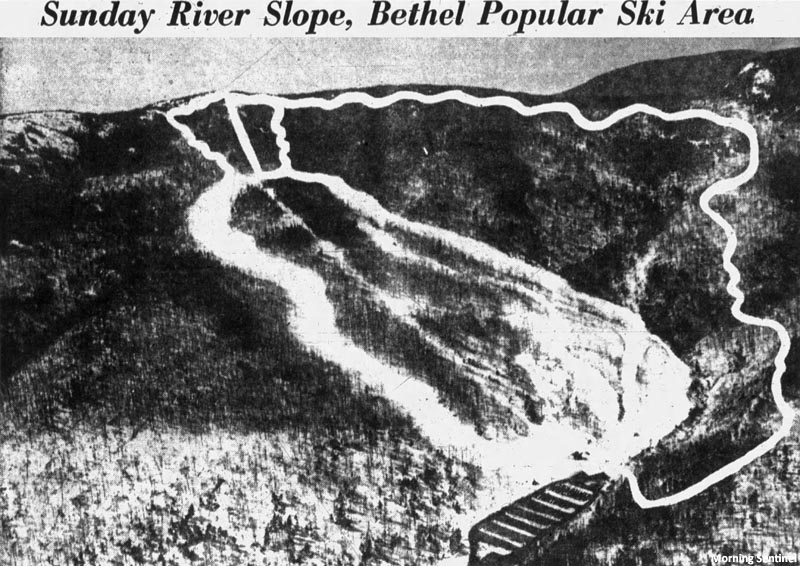
A rendering of the 1961 expansion |
In August 1961, Sunday River announced it would be constructing a T-Bar to the summit snowfields (the ledges above the present day Locke Mountain top terminal). By this point, the T-Bar line and extensions of Cascade (later abandoned) and Sunday Punch were reportedly cut, while the 2.25 mile novice-intermediate Lazy River trail was planned. The 2,200 foot long T-Bar would increase Sunday River's vertical drop to 1,400 feet. In addition to the new trails and lift, the parking lot was expanded and a separate ski shop building constructed.
In November, Uel Gardner was announced as the new ski school director. The area picked up two feet of snow just before Thanksgiving, but opted not to open due to subsequent warm temperatures and ongoing construction. Instead, the season kicked off just before Christmas, following a moderate snow storm. The area soon saw record crowds.
January was subsequently a struggle following a rain event. Extensive snow cat work was reported as Sunday River rallied to keep the trails skiable. Manager John Rolfe worked with local mechanic Bob Kenniston to develop a snowcat-mounted sawdust blower, which attempted to ground up hardpack and push out granular. Ski races from other areas were relocated to Sunday River due to lack of snow in the region.
In February 1962, Sunday River hosted the Eastern Junior Alpine Ski Championships. High-placing competitors included Suzy Chaffee, Rick Chaffee, Sandra Bower, Ni Orsi, and Roger Buchika. The season likely came to a close in early April.
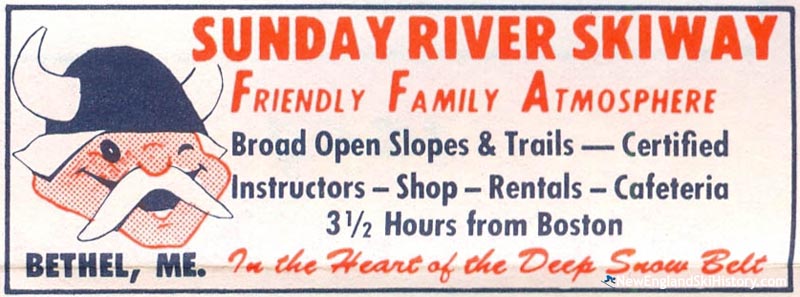
The smiling Viking logo |
1962 off-season improvements included relocating the novice rope tow, widening Rocking Chair, relocating a portion of upper Cascade, and overhauling Lazy River. The limiting factor was financing, with Murray Thurston telling the Portland Press Herald, "We can use all the money we can get for expansion." Meanwhile, one year after Mt. Abram adopted Bullwinkle as its mascot, Sunday River created a new logo featuring a smiling Viking.
The 1962-63 season kicked off on Christmas Day, following a recent snowfall. A significant wind event subsequently impacted operations, hampering holiday business. The snow blower was used to help with lower mountain skiing, while the upper mountain lift opened days later, though upper Cascade remained closed for a few more weeks due to inadequate snow. More snow soon arrived, allowing the area to operate into mid-April.
Mixing Bowl Expansion
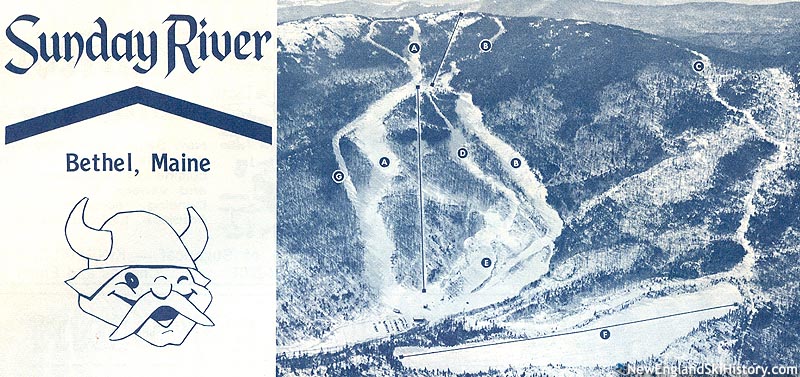
Sunday River in the mid 1960s |
The Mixing Bowl complex was constructed for the 1963-64 season in the present-day South Ridge area, served by a 2,535 foot long T-Bar. Not only was the $48,000 area designed to expand beginner terrain, it was smoothly graded to be skiable before the main mountain. A "large knoll" was flattened to allow skiers to descend from the lodge to the base of the new area, keeping it "completely separated" from the main mountain. Corporate president Murray Thurston told the Portland Evening Express, "We believe this to be one of the finest novice slopes to be found in New England. It provides gentle, rolling terrain necessary to instruction and the confidence of the inexperienced and beginner skier."
Winter was late to arrive in 1963-64, resulting in the postponement of Christmas events at Sunday River. The season likely didn't start until mid-January, with the new Mixing Bowl debuting on opening day. Rain intervened a few days later, causing the postponement of one race and requiring walking for another. John Rolfe told the Portland Press Herald, "We're running about 50 per cent behind last year," adding, "This is the worst winter yet in five years." The winter was so poor at that point in late January that some golf courses were still open. Snow eventually arrived in time for Sunday River to host February races that were relocated due to poor conditions in Rumford and Farmington.
In mid-February 1964, the Lewiston Sun Journal reported that Sunday River had ordered a new Hall T-Bar. It is not known what became of the order.
Warm temperatures, rain, and wind continued to plague Sunday River as March arrived. By the start of the month, business was still 30 to 35 percent down, with races being one of the few financial bright spots. Natural snow finally started to accumulate in mid-March, allowing the season to extend into the first full week of April.
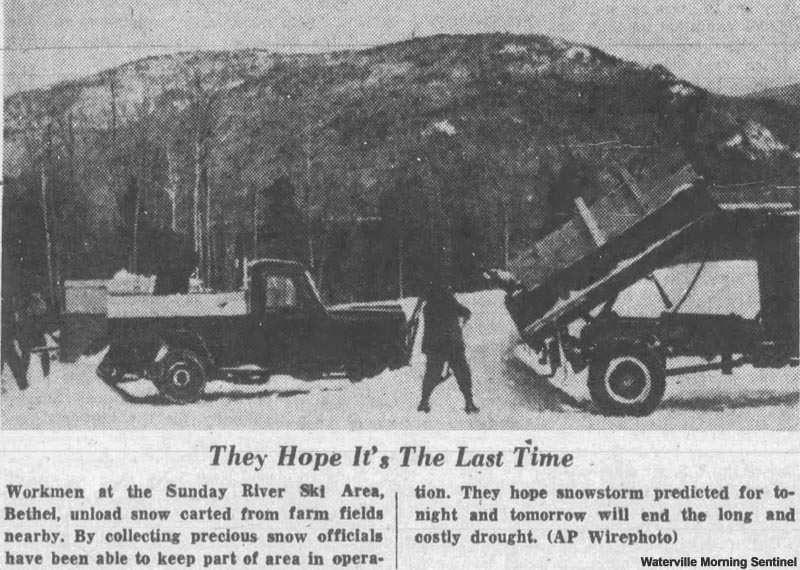
Trucking in snow (January 1965) |
Changes for the 1964-65 season included the new Cascade Cutoff trail (bypassing the "waterfall") and a summit warming hut. Base development ramped up with the construction of new A-frames, a sauna owned by ski school director Uel Gardner, and the new Sunday River Inn. The season started with an eight inch base on the lower mountain in mid-December. A January thaw shut down the area, forcing management to get creative to restore skiing. 700 yards of snow were trucked in from a nearby farm, covering 160,000 square feet of a lower mountain slope with an 8 inch base. Another thaw hit in February, putting a further damper on the season until timely snow paved the way for a strong Washington's Birthday weekend. Betty Potter of the Waterville Morning Sentinel opined, "It looks as though Washington's birthday weekend officially opened ski season this year." Unfortunately it was not the case, as the poor weather continued into March. Sunday River responded by suspending midweek skiing to preserve the meager base depths of 0 to 10 inches. Nevertheless, the season extended to the first weekend of April and was the strongest to date in terms of visitation at the growing area.
Improvements for the 1965-66 season included grading existing trails for better skiing with minimal snowpack and likely adding Bim's Whim from the summit. The season started in mid-December with lower mountain skiing.
The Mixing Bowl became the site of Sunday River's first snowmaking installation in 1970-71.
Despite these advances, Sunday River was still behind the times. An early 1970s Skiing magazine review stated the small lodge was "so crowded it looked like one of the Titanic's lifeboats. And the cafeteria has about the range of lifeboat survival rations."
Big Changes
Sunday River finally took the plunge into the world of chairlifts for the 1971-72 season, when it installed a 5,100 foot long Pullman-Berry double chairlift to its new Barker Mountain area. The following year, the ski area was taken over by Killington's parent company and, in 1973, Les Otten was named General Manager.
Under the new ownership, the ski area saw numerous under the hood changes, such as improved snowmaking, grooming, and base facilities. Work on Sunday River's second base area, an extension downward of the Mixing Bowl complex under the name South Ridge, began in 1978.
Otten Takes Over
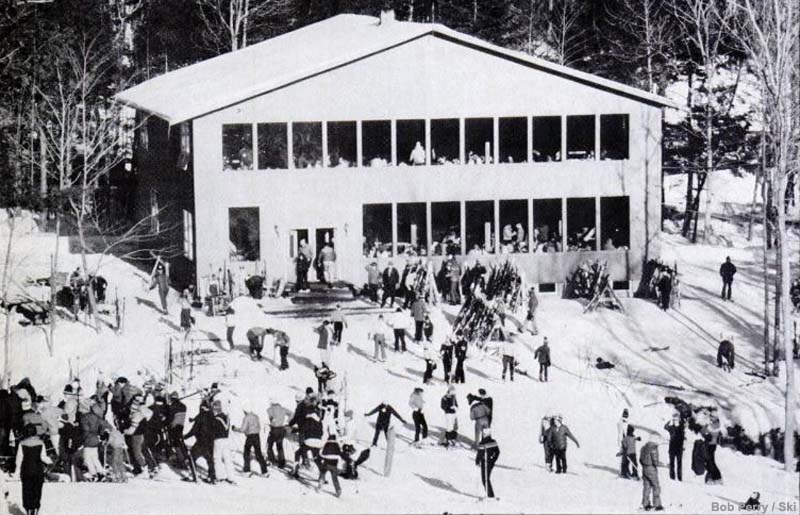
The South Ridge base area circa the early 1980s |
Les Otten purchased the ski area in 1980 and quickly turned dreams into reality while growing skier visits exponentially. Otten claimed to finance some of his work by selling scrap metal lying around the property.
For 1981-82, Otten pushed through an aggressive expansion program including the addition of the South Ridge double chairlift, 20 more acres of snowmaking, and 4 new trails.
Sunday River's first triple chairlift, the Locke Triple, was installed for the 1984-85 season. Along with Pleasant Mountain's summit lift, the Locke chairlift was the first triple in Maine. In light of the infrastructure changes and reworked trails, Les Otten told Skiing magazine, "basically what we did was take the mountain apart and put it back together the way we wanted it." Now it was time to expand.
New Peaks

Spruce Peak circa 1987 |
Sunday River's growth quickly accelerated as the mid 1980s arrived. Rather than focus on developing high end real estate, Otten went for a different approach, telling Ski magazine, "we're a middle class ski area all the way. We want to provide the average skier with a condo he would have to pay $80,000 to $120,000 for elsewhere."
On the strength of real estate development, North Peak was added for the 1985-86 season. 1986-87 brought the addition of Spruce Peak on the then-western end of the resort, served by yet another triple chairlift. Skiing magazine described the new wide, steep groomers as "largely responsible for Sunday River's bright new reputation among collegians and the yacht-club set."
For 1987-88, the first phase of Whitecap debuted with the lower Whitecap trail pod. Dubbed as the largest single season expansion ever in the Northeast, 1987-88 also saw the installation of the Sunday River Express, Maine's first high speed detachable quad chairlift, as well as an expansion of the Barker lodge. The upper portion of Whitecap was added for the 1988-89 season, including the legendary White Heat.
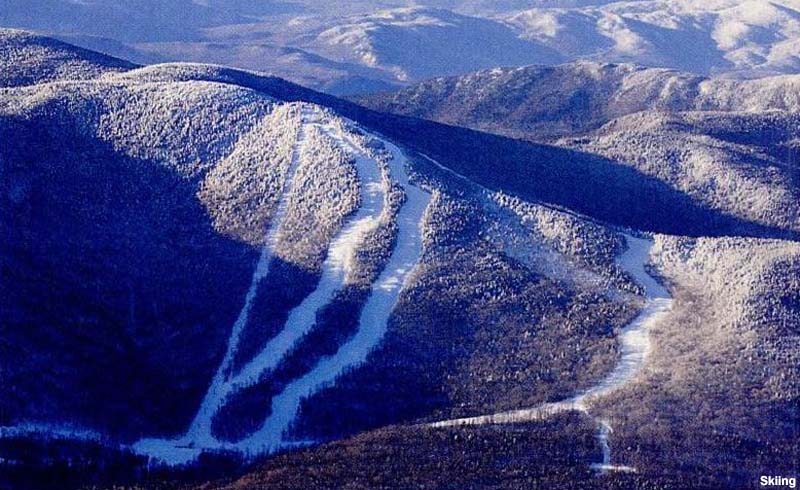
The Jordan Bowl circa its debut in 1994-95 |
Sunday River had started the decade as a minor player in the industry and finished the decade as one of the largest in the East. Despite this, the investments did not halt in the new decade. What was billed as the first of its kind in the East, the Sunday River Mountain Bike Park debuted in June 1991. Aurora Peak was added for 1991-92, the Summit Hotel and Conference Center for 1992-93, the Jordan Bowl in 1994, and Oz in 1995. In the mid 1990s, the editor of Ski magazine stated that Sunday River had "gone from a blip to a major force in the East," while noting it was "built quickly and cheaply." Les Otten told the New York Times, "This isn't just a ski area, it's an entertainment company."
Mergers and Acquisitions
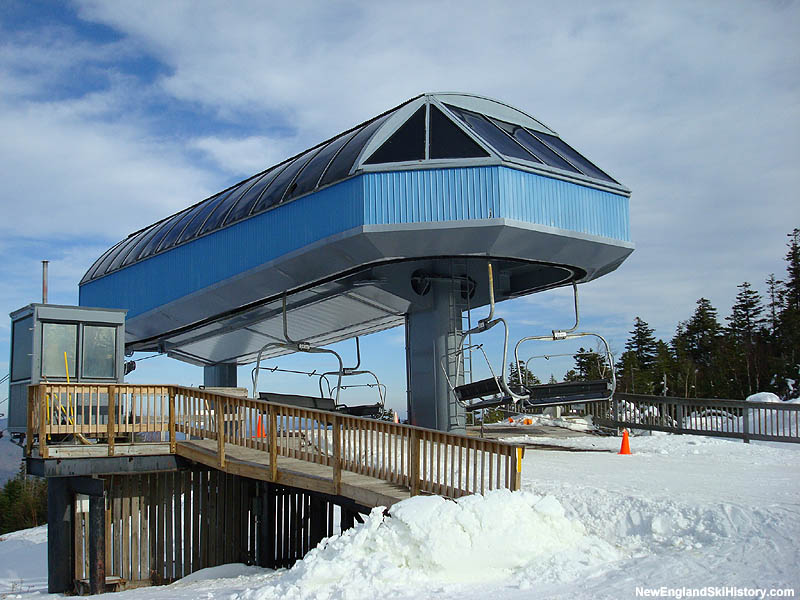
The Sunday River Express in 2007 |
Meanwhile, Les Otten formed LBO Resort Enterprises in 1994 and started to compete with former boss Pres Smith's S-K-I Ltd.. In rapid fashion, LBO purchased Attitash, NH and Sugarbush, VT that year, followed by Cranmore, NH in 1995.
The following year, LBO and S-K-I merged to form American Skiing Company, bringing Sunday River and rival Sugarloaf under the same ownership.
For the following season, the Perfect Turn Express detachable quad was installed on North Peak, while the short lived Spruce Cliffs trail was cut on Spruce Peak. Meanwhile, Sunday River was trying to capitalize on the growing popularity of snowboarding, featuring eight parks, a lighted halfpipe on Lower Tempest, and hosting the USSA National Snowboard Championship in March of 1998.
With the American Skiing Company quickly sliding into financial doom, Sunday River's long term trend of massive expansion came to a grinding halt. Beyond the lack of investment in the ski area, four season operations were effected when the mountain bike operation was suspended in 2003. On August 8, 2007, American Skiing Company sold Sunday River and Sugarloaf for $77 million to Boyne USA Resorts, which immediately sold the assets to CNL Properties Inc. while procuring a lease agreement to operate the areas. Lift served mountain biking soon resumed at Sunday River.
Sunday River co-founder Mike Thurston passed away on November 25, 2008 at the age of 87.
Boyne Takes Over
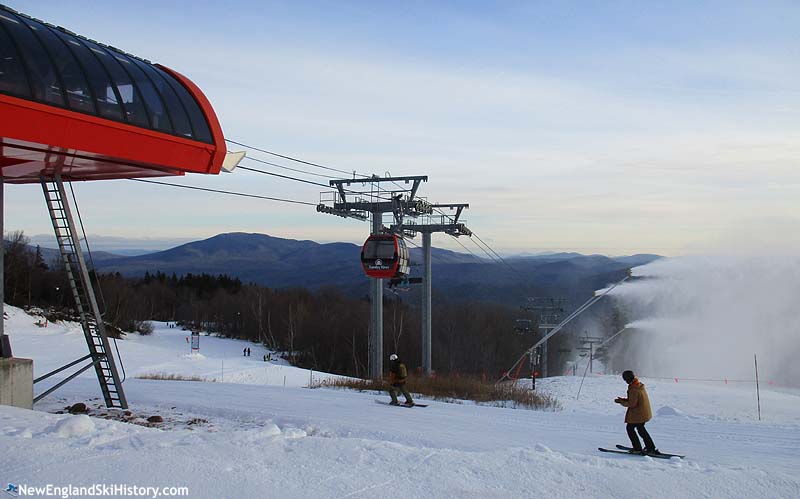
The Chondola in 2017 |
For the 2008-09 season, the new ownership made quite a splash by installing New England's first chondola (a combined gondola and chair lift), while also adding night skiing. In addition, Sunday River continued to see heavy investment in snowmaking, resulting in it having October opening days more often than not.
While sitting idle on July 10, 2016, the top terminal of the Spruce Peak Triple suffered a catastrophic failure, resulting in the lift being totaled. Due to the nature and the timing of the event, Spruce Peak was without lift service for the 2016-17 season. Lift service was restored to the peak in December 2017 when a new Doppelmayr triple chairlift was opened.
Following his retirement from competitive mogul skiing after the 2018 Winter Olympics, Gould Academy alum and Bethel native Troy Murphy created his Donny Pelletier persona in 2018. Donny quickly became a popular figure at Sunday River, staging events and appearing in promotional material.
In March 2019, Sunday River announced it would cease operating its mountain bike park and zip line tours. That off-season, a new T-Bar was installed on lower Locke Mountain for racing purposes.
For the 2022-23 season, the Jordan Bowl Express Quad was replaced with a new high speed eight person bubble chair. Following the season, the Barker Express Quad was removed to make way for a high speed six-pack.
The 2023-24 season kicked off with top to bottom skiing off the Jordan 8 chairlift in mid-November. The new Barker 6 chairlift debuted on December 9. On December 18, a massive rain storm devastated Sunday River and the surrounding region, shutting down the resort for nearly a week. A mudslide filled the Gould Academy building in the Barker base area while water cascaded around the new Barker 6 base terminal. Trails and roads suffered washouts, including the loss of a culvert resulting in occupants being stranded at the Grand Summit Hotel. The resort reopened for limited operations on December 23, restoring full service soon thereafter.
NewEnglandSkiConditions.com Reports
| Month |
Average Percent of Terrain Open |
| October | 4% (4 reports) |  | | November | 10% (15 reports) |  | | December | 28% (25 reports) |  | | January | 69% (21 reports) |  | | February | 86% (9 reports) |  | | March | 78% (10 reports) |  | | April | 35% (26 reports) |  |
|
| Recent Conditions Reports |
 | Dec. 7, 2025 by snowphoenix
Packed Powder, Variable Conditions |
 | Apr. 27, 2025 by alpinevillagepres
Spring Snow, Bare Spots |
 | Apr. 7, 2025 by nordicgal
Variable Conditions, Spring Snow |
 | Apr. 6, 2025 by rocket21
Spring Snow, Spring Snow |
 | Jan. 25, 2025 by rocket21
Loose Granular, Loose Granular |
|
|
| Sunday River on NewEnglandSkiConditions.com |
NewEnglandSkiIndustry.com News
| Recent Articles |
| Pre-Thanksgiving Skiing at Ski Areas in Four States - Nov. 22, 2025 | | Ski Season Resumes Tomorrow - Nov. 13, 2024 | | Chairlift-Served Ski Season Starts Tomorrow - Oct. 30, 2024 | | Pleasant Mountain to Install High Speed Quad - Mar. 6, 2024 | | Ski Areas Devastated by Catastrophic Storm - Dec. 18, 2023 | | Mid-October 2023 Lift Construction Roundup - Oct. 15, 2023 | | Mid-June 2023 Lift Construction Roundup - Jun. 11, 2023 | | Early May 2023 Lift Construction Roundup - May. 7, 2023 | | Sunday River Announces Two New Lifts for 2023-24 Season - Feb. 16, 2023 | | Lift Construction Continues as December Starts - Dec. 4, 2022 | | Sunday River NewEnglandSkiIndustry.com News Page |
Expansion History
Image Gallery
Lifts
Click on lift name for information and photos
Maps
Year by Year History
Adult Weekend Full Day Lift Ticket; Adult Full Price Unlimited Season Pass. Window price, including RFID fee and taxes when known.
| 2020s |
Ticket Price |
Season Pass Price |
Pass Payback |
Opening Day |
Closing Day |
Skier Visits |
| 2025-26 | $159.00 |  | $1659.00 |  | 10.4 days | November 12 | | |  | | | 2024-25 | $159.00 |  | $1599.00 |  | 10.1 days | October 31 | April 27 | |  | | | 2023-24 | $159.00 |  | $1619.00 |  | 10.2 days | November 14 | April 28 | |  | | | 2022-23 | $149.00 |  | $1609.00 |  | 10.8 days | November 17 | April 23 | |  | | | 2021-22 | $139.00 |  | $1599.00 |  | 11.5 days | November 18 | April 24 | |  | | | 2020-21 | $119.00 |  | |  | | November 23 | April 24 | |  | | | 2019-20 | $109.00 |  | $1419.00 |  | 13.0 days | November 9 | March 15 | |  | |
| 2010s |
Ticket Price |
Season Pass Price |
Pass Payback |
Opening Day |
Closing Day |
Skier Visits |
| 2018-19 | $105.00 |  | $1389.00 |  | 13.2 days | October 19 | April 28 | |  | | | 2017-18 | $105.00 |  | $1349.00 |  | 12.8 days | November 11 | April 29 | |  | | | 2016-17 | $99.00 |  | $1309.00 |  | 13.2 days | November 23 | May 1 | |  | | | 2015-16 | $89.00 |  | $1245.00 |  | 14.0 days | October 19 | May 1 | |  | | | 2014-15 | $89.00 |  | $1245.00 |  | 14.0 days | November 3 | May 2 | |  | | | 2013-14 | $87.00 |  | $1210.00 |  | 13.9 days | October 26 | April 21 | |  | | | 2012-13 | $85.00 |  | $1175.00 |  | 13.8 days | November 6 | April 21 | |  | | | 2011-12 | $80.00 |  | $1149.00 |  | 14.4 days | October 29 | April 15 | |  | | | 2010-11 | $79.00 |  | $1079.00 |  | 13.7 days | October 22 | April 24 | |  | | | 2009-10 | $77.00 |  | $1049.00 |  | 13.6 days | October 14 | April 19 | |  | |
| 2000s |
Ticket Price |
Season Pass Price |
Pass Payback |
Opening Day |
Closing Day |
Skier Visits |
| 2008-09 | $77.00 |  | $1049.00 |  | 13.6 days | October 31 | April 26 | |  | | | 2007-08 | $72.00 |  | $999.00 |  | 13.9 days | October 31 | April 27 | |  | | | 2006-07 | $67.00 |  | $1400.00 |  | 20.9 days | November 21 | April 29 | |  | | | 2005-06 | $59.00 |  | $1300.00 |  | 22.0 days | November 17 | April 17 | 473,000 |  | | | 2004-05 | $59.00 |  | $1100.00 |  | 18.6 days | November 10 | | 525,000 |  | | | 2003-04 | $56.00 |  | $1249.00 |  | 22.3 days | November 10 | | 523,000 |  | | | 2002-03 | $53.00 |  | $1249.00 |  | 23.6 days | November 1 | | 501,000 |  | | | 2001-02 | $52.00 |  | $1245.00 |  | 23.9 days | | May 1 | 521,000 |  | | | 2000-01 | $51.00 |  | |  | | | | 547,000 |  | | | 1999-00 | $49.00 |  | |  | | | May 1 | 513,000 |  | |
| 1990s |
Ticket Price |
Season Pass Price |
Pass Payback |
Opening Day |
Closing Day |
Skier Visits |
| 1998-99 | $49.00 |  | |  | | | | 526,000 |  | | | 1997-98 | $47.00 |  | |  | | October 23 | | 552,000 |  | | | 1995-96 | |  | |  | | October 30 | | |  | | | 1994-95 | $43.00 |  | |  | | November 10 | | 546,000 |  | | | 1993-94 | |  | |  | | October 11 | | 525,000 |  | | | 1992-93 | $39.00 |  | |  | | November 1 | | 525,000 |  | | | 1991-92 | $37.00 |  | |  | | | May 17 | 502,507 |  | | | 1990-91 | $36.00 |  | |  | | November 9 | | 439,000 |  | | | 1989-90 | $33.00 |  | |  | | November 1 | May 24 | 396,000 |  | |
| 1980s |
Ticket Price |
Season Pass Price |
Pass Payback |
Opening Day |
Closing Day |
Skier Visits |
| 1988-89 | $30.00 |  | |  | | November 13 | May 18 | |  | | | 1987-88 | $27.00 |  | |  | | | May 18 | |  | | | 1986-87 | $24.00 |  | |  | | November 12 | | 240,000 |  | | | 1985-86 | $22.00 |  | |  | | | | 190,000 |  | | | 1984-85 | $20.00 |  | |  | | November 21 | | |  | | | 1983-84 | $18.00 |  | |  | | November 15 | | 110,000 |  | | | 1982-83 | $16.00 |  | |  | | | | |  | | | 1981-82 | $15.00 |  | |  | | November 24 | | |  | | | 1980-81 | $13.00 |  | |  | | November 15 | | |  | | | 1979-80 | $10.50 |  | |  | | December 2 | April 7 | 40,000 |  | |
| 1970s |
Ticket Price |
Season Pass Price |
Pass Payback |
Opening Day |
Closing Day |
Skier Visits |
| 1978-79 | $9.75 |  | |  | | November 16 | | |  | | | 1977-78 | $9.75 |  | |  | | November 19 | May 3 | |  | | | 1976-77 | $9.25 |  | |  | | November 10 | April 10 | |  | | | 1975-76 | $8.00 |  | |  | | October 31 | April 16 | |  | | | 1974-75 | $8.00 |  | |  | | November 16 | May 2 | |  | | | 1973-74 | $7.00 |  | |  | | November 18 | April 27 | |  | | | 1972-73 | $7.00 |  | |  | | November 22 | April 21 | |  | | | 1971-72 | $7.00 |  | |  | | | | |  | | | 1970-71 | $6.00 |  | $90.00 |  | 15.0 days | | | |  | | | 1969-70 | $6.00 |  | |  | | | | |  | |
| 1960s |
Ticket Price |
Season Pass Price |
Pass Payback |
Opening Day |
Closing Day |
Skier Visits |
| 1968-69 | $4.50 |  | $60.00 |  | 13.3 days | | | |  | | | 1967-68 | $4.50 |  | |  | | | | |  | | | 1966-67 | |  | |  | | | April 2 | |  | | | 1965-66 | |  | $60.00 |  | | December 18 | | |  | | | 1964-65 | $4.00 |  | $60.00 |  | 15.0 days | December 12 | April 4 | |  | | | 1963-64 | $4.00 |  | $60.00 |  | 15.0 days | January 11 | | |  | | | 1962-63 | $4.00 |  | $50.00 |  | 12.5 days | December 25 | | |  | | | 1961-62 | |  | $50.00 |  | | December 20 | April 8 | |  | | | 1960-61 | |  | $50.00 |  | | December 22 | April 16 | |  | | | 1959-60 | |  | $50.00 |  | | December 29 | April 10 | |  | |
Visitor Memories
| "Sunday River was in many ways a dream of Bethel life resident, Mike Thurston who was one of the first skiway presidents. He was part of a core group that helped raise cash and do the necessary work which resulted in recreational downhill skiing coming to Newry. The mountain (sometimes referred to as "the hill" by my parent’s generation and which within this article is referred to a ridge) was our winter home growing up as kids in the 1960s and which our parents, whether they were beginners such as mine were or they were seasoned ski coaches such as Gould Academy ski coach Paul Kailey, was one big family. As the mountain grew through the 60s, more and more people began skiing there. With the advent of bringing Killington in as general partners in the early 70s, the "hometown effect" started changing into a destination resort. Today, Sunday River has essentially accomplished its goal of ensuring the economic health of the Bethel area which was likely the mission of the Bethel Area Development’s goal in 1958 when it
all started. " | | Curtis Cole, Jan. 25, 2023 | | "If you look at Sunday River Trail maps before 2014, you can see 2 lifts near the white cap base area next to the Tempest Quad. (Lift #9). These lifts were used to pull tubes up Tempest trail for tubing, and were labeled as lifts 17 and 18. Lift number 17 was the longer, better, and more safer one to ride, while lift 18 was short lived and was soon removed to make room for the new “Tempest Ridge†townhouses. It is also noted that lift 17 was longer lived, only to be fully removed around 2014. Tubing at Sunday River did not stop after the removal of lifts 17 & 18 however, in 2013 tubing was moved to skiers right of the Sundance Surface lift (#16) near the South Ridge Base area, where it still continues every year.
Today, tubing at white cap ( as well as many other children's activities at white cap ) have been either discontinued, or have been moved to South Ridge to create a more centralized hub of activity around Sunday River’s main base of operations. This includes activities like pond skimming, the legendary “Bust n’ Burn†mougel competitions, and the annual firefighters race, all once held on the slopes of White Cap. Tubing at White Cap however, always seemed to stick around, even through the great recession of 2008, but the construction of the chondola at South Ridge changed all that. With the White Cap lodge deteriorating, and the South Ridge lodge prospering, Sunday River discontinued many of the activities at white cap, and the Tubing Lifts were on the list. The last season to ride the tubing park at White Cap was in the 2011 - 2012 season, and soon after were dismantled. The last remnant of the tubing park on the map could still be seen on the 2012-13’ season, but did not operate.
Today, the only parts that remain are the top and bottom foundations of both lifts, and can be easily seen from the Tempest quad.
" | | Tucker Stanton , Apr. 16, 2018 | | "my son and I remember the small only "lodge" building that had several long benches to change shoes to ski boots on,leaving lungh bags and other gear below. after a couple runs the cold drove us to visit the near by ski eqiiptment sales building {the size of a two car garage} better ski hats goggles and mittens were bought...plus dad got his first new form to feet boots!!! not all that busy, we made several more runs until tuckered out, then had cocoa and hot dogs. the 20'foot lunch counter also served hamburgers had potato chips and a few candy bars. small cozy ultra friendly and a hustle bustle fun long day. excellent snow, and only the first of many trips from Bridgton for several winters. then it began to grow, have condo's,outside hot tubs with bikini gals splashing around. it actually out grew us,,,so many people! sort of lost that homey feeling, and we began visiting loon,wildcat,sugarloaf and of course pleasant mts. question: when did the chawnee ever even visit main??? it'll always remain pleasant mt.ski area to us.... just saying! " | | john hunt, Dec. 29, 2017 | | "Teaching the kids how to ski in the mixing bowl
And now I am teaching their kids on the same trail " | | Dean Wallace, Mar. 1, 2017 |
|
External Links
Sunday River - official site
Sunday River - Wikipedia
|
Last updated: November 19, 2024
|



